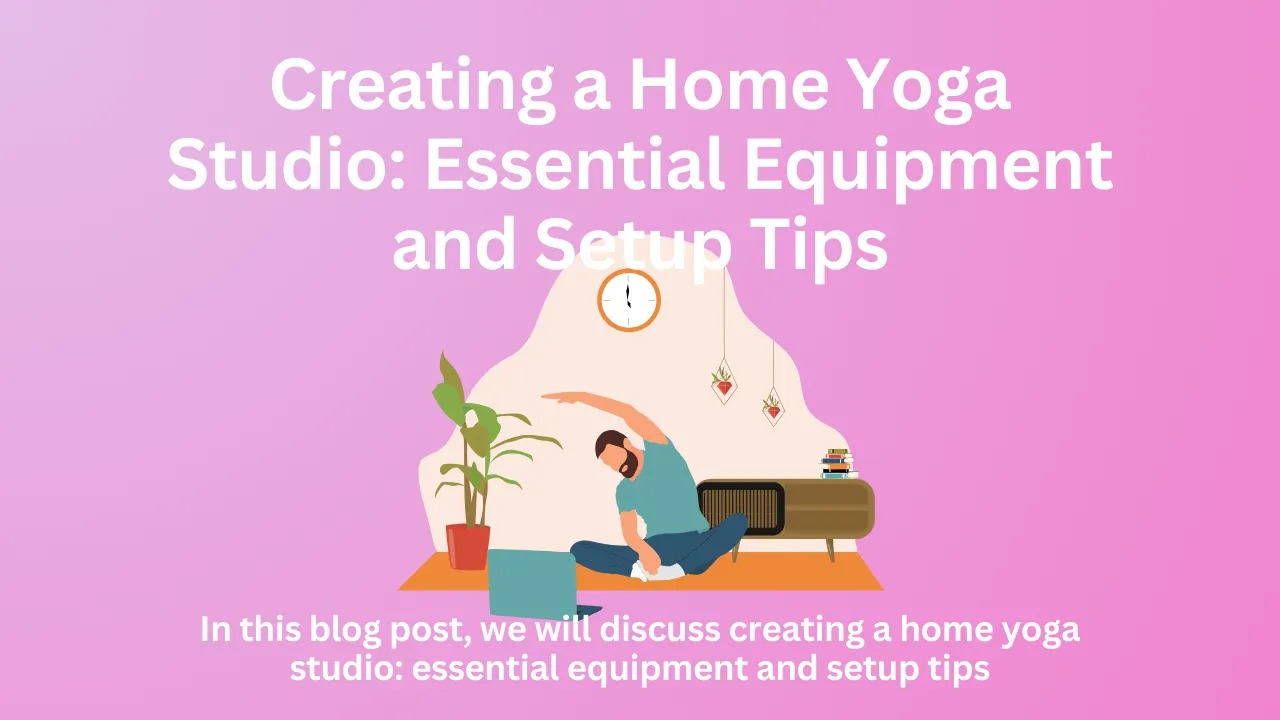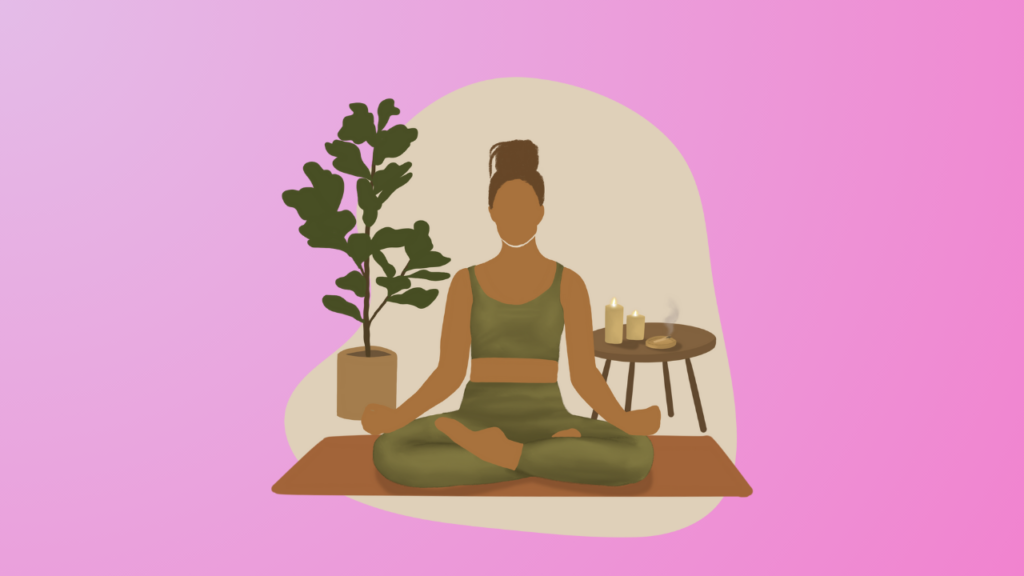Creating a Home Yoga Studio: Essential Equipment and Setup Tips

For beginners, welcome to my yoga blog, a comprehensive companion to the rudiments of yoga outfits. In this blog post, we will show you how to produce a home yoga plant with essential outfits for those who join the yoga trip to stay fit and calm—and also dispel common misconceptions and shine a light on what truly matters.
My dream’s always been to enjoy a yoga room or at-home plant. It has also shown me the significance of the size of my at-home yoga space and that I do not need a separate area to produce a unique and individualized tone-care yoga area. Nearly all yoga exercises require the use of certain objects, numerous of which are standard outfits for yoga workrooms.
These Are Essentials For An At-Home Yoga Studio
1. Yoga Mats
A yoga mat’s purpose is to give stability and help slips and falls while rehearsing. Due to their thick construction, yoga mats give joints the softening support they need to perform acts easily and comfortably. While lower-priced mats may appear like a good deal, spend your capital on a high-quality mat and make sure it’s long-lasting and provident. A mat that strikes a balance between safety and allowing for natural movement should be bought. It should have enough grip without being excessively sticky.
2. Yoga Blocks
Using blocks in your yoga practice is a great technique to increase support. Usually, I prefer to use them for many different asanas, including sun salutations. These environmentally friendly blocks are both educational and adorable! In achieving proper alignment and enhancing inflexibility, yoga blocks are protean props. Yoga blocks promote safety, help with injury, and give support in acts where reaching the bottom may be grueling. Investing in a set of quality blocks is recommended; they can acclimatize to your practice as you progress in chops and strength.

3. Big Cushions Or Pillows
Properly sized pillows might be useful for supporting yourself during yoga poses or meditation.
4. Gorgeous flora
There are several health and wellness advantages of being in nature. Even some plants naturally purify the air! Embrace your surroundings with your favorite flora. They are also decorative!
5. Computer or Smartphone
You can watch yoga classes taught by an instructor on your laptop or smartphone, or you can practice on your own. This is my favourite choice since it helps me stay focused and I can do it whenever I’m feeling like doing some yoga.
Ideas for Setting Up a Fantastic At-Home Yoga Studio
The opportunity to do yoga and meditation easily and without interruption is the main advantage of having a dedicated area at home. Even while having a dedicated yoga space at home is preferable, you may still simply designate a small area of your living room or bedroom for yoga practice. Your yoga retreat turns into a holy space where you may relax, recharge, and focus deeply on your practice. It also provides encouragement and inspiration for a regular at-home yoga practice.
Reasons to Have a Specialized Home Yoga Area
By encouraging regular practice, having a dedicated yoga area in your house may enhance your general health and well-being. Numerous additional advantages of a home practice include stress, money, energy, and time savings. You may put your troubles and anxieties away and concentrate just on your practice in a dedicated location. Ideally, it turns into a haven where you can escape the pressures and anxieties of the outside world.
How to Set Up a Yoga Studio At Home?
It takes very little work and some forethought to set up a home yoga studio. To improve the effectiveness of your meditation practice, it’s essential to provide a relaxing setting. A yoga studio should have a comfortable, serene atmosphere. It should be decorated to suit your spiritual requirements and sense of style.
1. Set Aside A Spot for Yoga
Select a space in your home where you can consistently practice. No matter whether it’s a room in your home or a dedicated studio, you must ensure that you will only use it for your mindfulness, yoga, and meditation exercises. This might be an unused area in your house, a spare bedroom, or a part of the living room.
A home yoga studio should ideally start at about 20 square feet. You’ll have a comfortable space to practice your poses as a result. Make sure you have enough space to keep your props and to do your sun salutations. If you want to practice handstands and other inversions, make sure you have enough room around you to prevent damaging anything in the event of a fall or tumble.
2. Produce With Purpose
For yoga practices, the ideal terrain is one of serenity and relaxation. To encourage calmness, serenity, and attention, you want to design a terrain. To imagine the layout for your perfect room, could you spend some time and feel it? Make a list of three to five particular pretensions you would want to negotiate with your dream yoga plant, and use this list to inform your design opinions.
3. Elect Soothing Colours
Your color scheme should be a reflection of your yoga practice’s overall tone and pretensions. For example, you may use soothing colors like blues and flora if you wish to decompress. Brighter colors like red and unheroic are good choices if you want to feel more reenergized tête-à-tête. Whatever your purpose, be sure the colors you choose work well together.
For your wall, choose warmer white tinges or subdued, colder tones, as these colours draw attention down rather than towards them. Brighter and more vibrant colours might be used as accentuations on minor cabinetwork pieces or props

4. Use Lights to Create The Right Atmosphere
The lighting has a big impact on our mood. While too much light may lead to headaches, migraines, and exhaustion, the proper color temperature, and brightness can promote alertness, creativity, and attention. The ideal lighting will be filtered natural light, but you’ll need additional lighting if your practice is at night or if your room has tiny windows. To limit the quantum of light that enters our houses, suppose installing a dimmer switch or buying lights with 3-way switches.
- Dim lighting is preferable for further comforting types like gentle, yin, and restorative yoga, while brighter lighting is better for active styles like vinyasa and ashtanga.
- Swab lights and candles are excellent options for low illumination that promote contemplation.
5. Incorporate Elegance & Motivation
This bone’s conception is straightforward detect something lovely, like a picture, form, or oil, and allow it to inspire you. This may be a picture of a chum, tutor, or relative, or it might be an artwork. Whatever it is, just take a look at it and consider why it brings you similar joy.
6. Pour Some Fragrance Into Your Environment
Launch by lighting an ambrosial candle, burning an incense stick, or simply spritzing yourself with essential canvases to sanctify your home yoga plant. Just be careful—too important a bank or radiation might vitiate your breathing. Consider precisely what you use, since colorful scents affect us in different ways. While some individuals like racy scents, others are more drawn to sweet bones. Try several combinations until you discover one that works stylishly for you.
7. Use Indoor Plants to Purify the Air
Taking care of plants and being around them promotes awareness, relaxation, and mental calmness. Additionally, plants contribute to the purification of the air in your house, which is particularly beneficial for pranayama and difficult poses. Seek out indoor plants that thrive in the amount of light available to them. Because they need very little water, succulents, cactus, snake plants, spider plants, and ferns are good options if you don’t have a green thumb.
8. Examine Your Figure in A Mirror
Any yoga studio or home practice area would greatly benefit from the inclusion of a full-size mirror. A large one will let you view yourself clearly, which will improve your understanding of how your alignment seems. As you practice your postures, it will increase your awareness and self-assurance.
9. Calm Down With a Candle
Candles aid in creating a calming atmosphere for asana practice and meditation. Invest in premium candles that emit no smoke or drips. Because natural soy candles burn cleaner than paraffin wax, give them a try. If you are apprehensive about burning anything when using them, go for LED-lit flameless candles.
10. Organize Your Music
You may improve your yoga or meditation practice with music. Select music that both uplifts and soothes you. Even though meditation music is often calming and serene, many different kinds of music might aid in relaxation. A small or medium-sized Bluetooth speaker should work excellently to give adequate volume for practice, depending on the size of your location.
11. Use Crystals for Protection & Healing
In yoga and meditation, crystals and gemstones are utilized to influence energy, mood, and attention. Crystals come in a variety of forms, each with unique characteristics. These may all be used for various purposes, such as cleaning, concentration, and protection. They also make lovely complements to any home practice space and magnify your goals.
12. Include Monuments To Serve As Inspiration
Buddhas and Hindu deities like Ganesha and Krishna may be found in stone, wood, or brass sculptures that can inspire your meditation. They may be arranged at any place throughout your yoga retreat. We may use statues to serve as a visible reminder of our goals. These may serve as a helpful reminder to remain in the moment, pay attention to your breathing, connect with your energy, and open your heart.
13. Make A Hallowed Altar
An altar is a wonderful place to gather everything you’ll need to assist your practice. It’s a place you make for yourself to reflect on your life and the experiences you want to have going forward. Establish a space where you may arrange cantones, incense, crystals, statues, pictures, and other objects that are connected to your spiritual path first. You could want to include each of the five components of nature. Just be sure that whatever you put there speaks to you personally.
14. Stock Your Studio With Necessities
While there aren’t many tools needed for practicing yoga, there are a handful that are necessary to help you with your practice. A yoga mat, a yoga block or two, and a yoga strap are required. You’ll need a mat towel, hand towels, and an effective space heater if you do hot yoga.
If you engage in gentle, restorative, or yin yoga, you may want to add some blankets and bolsters. A yoga ball, a meditation cushion, a chair, a pair of yoga wheels, and resistance bands are other things to think about. Stow your stuff out of sight but still accessible on a tiny shelf or in a roomy basket.
15. Maintain it NeatLY & Orderly
Every time you use your practice area again, it should seem brand-new and inviting. Establish a routine for putting away your props and cleaning the area after each session. Make sure to keep the area, your mat, and the props clean regularly.
Conclusion
Start by grazing on necessary items like yoga mats, blocks, napkins, and water bottles. Yoga isn’t set up in the absence of an outfit; rather, it’s set up in the conscious relationship one has with oneself and exercise. The quality of the outfit, which raises comfort, safety, and enjoyment, ultimately justifies the expenditures. Please use our contact form to reach out if you have any questions or are unclear. I hope you have an awful and fulfilling yoga practice soon!



0 Comments